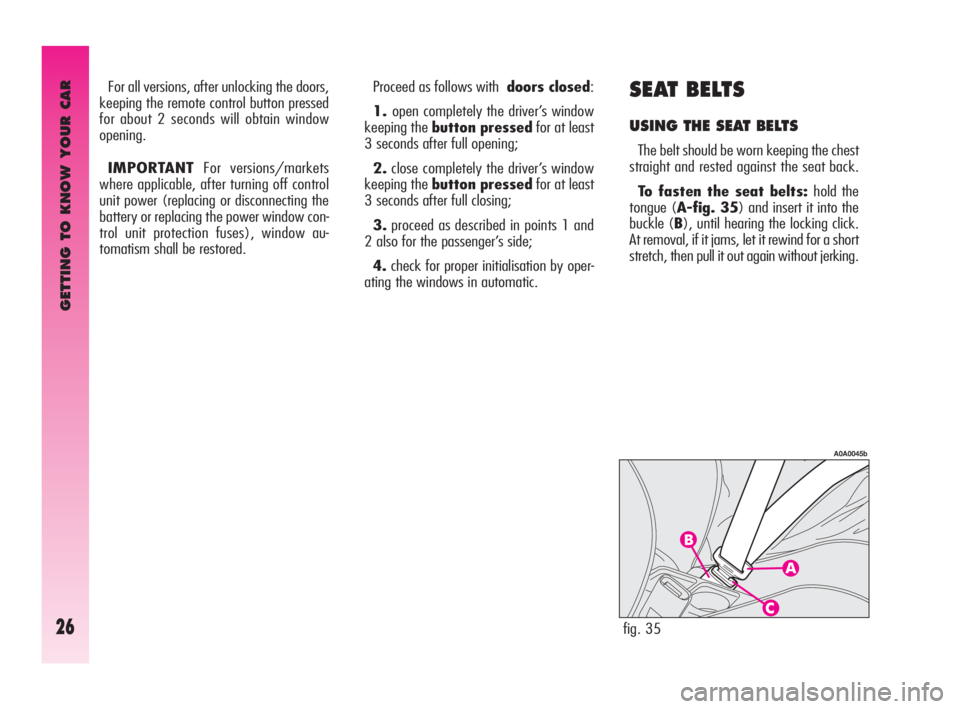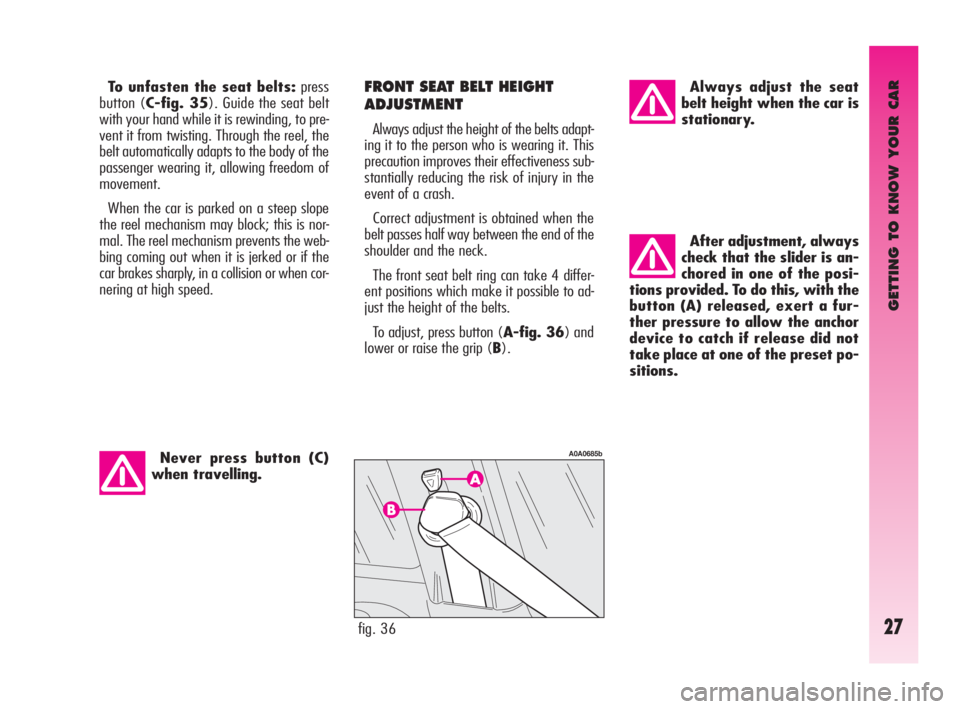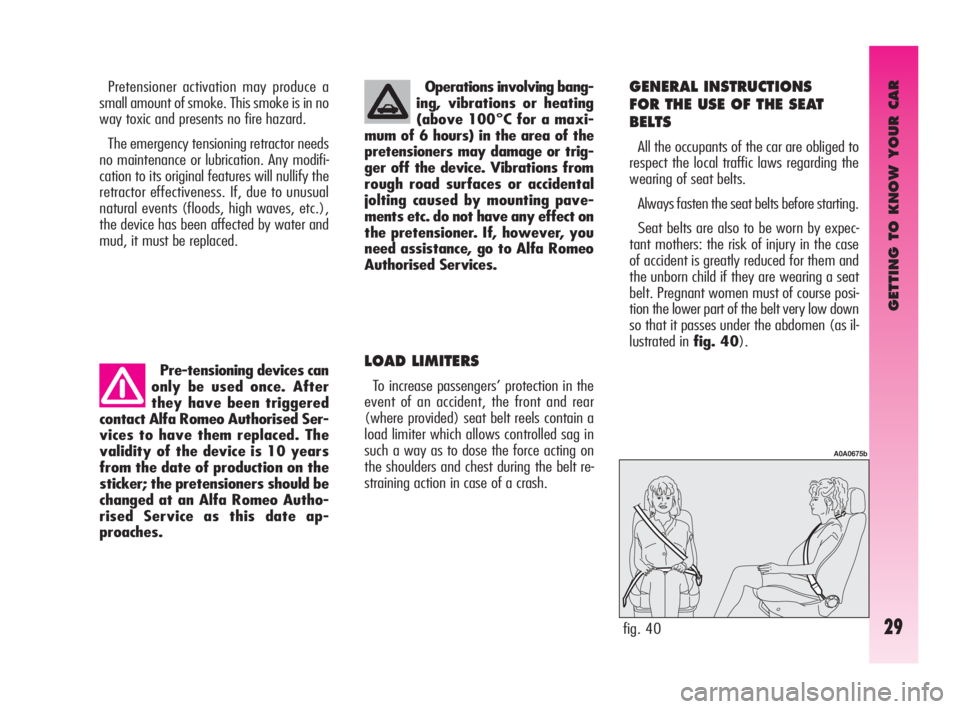belt Alfa Romeo GT 2009 Owner handbook (in English)
[x] Cancel search | Manufacturer: ALFA ROMEO, Model Year: 2009, Model line: GT, Model: Alfa Romeo GT 2009Pages: 271, PDF Size: 5.34 MB
Page 22 of 271

GETTING TO KNOW YOUR CAR
20
– raise the headrest to the highest posi-
tion, press both buttons (A-fig. 21) at the
side of the two supports, then remove the
headrest pulling them upwards;
– move the seat belts to the side extend-
ing them correctly without twisting;
– raise the levers (A-fig. 22) retaining
the back rests and tilt them forwards to ob-
tain a single loading surface (fig. 23).
fig. 21
A0A0607b
fig. 23
A0A0608 b
Total extension
Proceed as follows:
– check that seat buckles of the side belts
are fitted in the respective pockets on the
back rest (A-fig. 20) and the tab (B)
of the centre abdominal belt is inserted in
the support (C).
– pull the handles in the centre of the cush-
ions, then tilt them forwards;
fig. 20
A0A0623bfig. 22
A0A0608 b
IMPORTANTFor versions/markets
where applicable, the retainer levers are re-
placed by buttons (one for each side). To re-
lease the back rests and tilt them, use the
buttons themselves.
Page 23 of 271

GETTING TO KNOW YOUR CAR
21
Remember that headrests
should be adjusted so that
the nape, and not the neck,
rests on them. Only in this position
do they exert their protective ac-
tion in the event of a crash from
behind. Partial extension
For partial extension, proceed as follows:
– tilt the cushion required pulling the han-
dle at the centre of the cushion, then tilt-
ing the actual cushion;
– move the seat belt to one side extend-
ing it correctly without twisting;
– raise the lever retaining the back rest
and tilt it forwards.
To bring the seat back to its
normal position
Proceed as follows:
– move the seat belts to one side ex-
tending them correctly without twisting;
– raise the seat backs, pushing them back-
wards until hearing both clamping devices
click into place;
– set the cushions to the horizontal posi-
tion keeping the centre seat belt raised.
HEADREST ADJUSTMENT
(fig. 24)
The car may be fitted with two headrests
for the side seats and, depending on the trim
level, it may also have a third headrest in
the centre.
To use the headrest, raise it from the (2)
“non use position” and reach the (1) “all
removed” position. To restore the “non use
position”, press button (A-fig. 21) and
push the headrest downwards.
All rear headrests can be removed.
fig. 24
A0A0610b
The particular headrest shape interferes in-
tentionally with the rear passenger’s correct
position on the back rest; this forces the pas-
senger to raise the headrest to use it cor-
rectly.
IMPORTANT When using rear seats,
the headrests shall be kept in the “all re-
moved” position.
Page 28 of 271

GETTING TO KNOW YOUR CAR
26
SEAT BELTS
USING THE SEAT BELTS
The belt should be worn keeping the chest
straight and rested against the seat back.
To fasten the seat belts: hold the
tongue (A-fig. 35) and insert it into the
buckle (B), until hearing the locking click.
At removal, if it jams, let it rewind for a short
stretch, then pull it out again without jerking.
fig. 35
A0A0045b
Proceed as follows with doors closed:
1.open completely the driver’s window
keeping the button pressedfor at least
3 seconds after full opening;
2.close completely the driver’s window
keeping the button pressedfor at least
3 seconds after full closing;
3.proceed as described in points 1 and
2 also for the passenger’s side;
4.check for proper initialisation by oper-
ating the windows in automatic. For all versions, after unlocking the doors,
keeping the remote control button pressed
for about 2 seconds will obtain window
opening.
IMPORTANTFor versions/markets
where applicable, after turning off control
unit power (replacing or disconnecting the
battery or replacing the power window con-
trol unit protection fuses), window au-
tomatism shall be restored.
Page 29 of 271

GETTING TO KNOW YOUR CAR
27
After adjustment, always
check that the slider is an-
chored in one of the posi-
tions provided. To do this, with the
button (A) released, exert a fur-
ther pressure to allow the anchor
device to catch if release did not
take place at one of the preset po-
sitions.
Never press button (C)
when travelling. To unfasten the seat belts:press
button (C-fig. 35). Guide the seat belt
with your hand while it is rewinding, to pre-
vent it from twisting. Through the reel, the
belt automatically adapts to the body of the
passenger wearing it, allowing freedom of
movement.
When the car is parked on a steep slope
the reel mechanism may block; this is nor-
mal. The reel mechanism prevents the web-
bing coming out when it is jerked or if the
car brakes sharply, in a collision or when cor-
nering at high speed.
Always adjust the seat
belt height when the car is
stationary. FRONT SEAT BELT HEIGHT
ADJUSTMENT
Always adjust the height of the belts adapt-
ing it to the person who is wearing it. This
precaution improves their effectiveness sub-
stantially reducing the risk of injury in the
event of a crash.
Correct adjustment is obtained when the
belt passes half way between the end of the
shoulder and the neck.
The front seat belt ring can take 4 differ-
ent positions which make it possible to ad-
just the height of the belts.
To adjust, press button (A-fig. 36) and
lower or raise the grip (B).
fig. 36
A0A0685b
Page 30 of 271

GETTING TO KNOW YOUR CAR
28
Rear seat belts shall be worn as shown in
fig. 38.Fig. 39shows improper belt fas-
tening. To tilt the back rest see paragraph
“Boot extension”.
IMPORTANTThe centre rear seatbelt is
installed on request only for versions/mar-
kets on which it is required.
IMPORTANTRemember that, in the
event of an accident, any passengers occu-
pying the rear seats who are not wearing
a seat belt not only subject themselves to
great personal risk, but constitute a danger
to the occupants of the front seats.PRE-TENSIONING DEVICES
To increase the efficiency of the front seat
belts, the car is fitted with pre-tensioning de-
vices. These devices “feel” that the car is
being subject to a violent impact by way of
a sensor and rewind the seat belts a few
centimetres. In this way they ensure that
the seat belt adheres to the wearer before
the restraining action begins.
The seat belt locks to indicate that the de-
vice has intervened; the seat belt cannot be
drawn back up even when guiding it man-
ually.
IMPORTANTThe pretensioner will give
maximum protection when the seat belt ad-
heres snugly to wearer’s chest and hips.
fig. 39
A0A0387b
fig. 38
A0A0386b
fig. 37
A0A0686b
REAR BELTS
To fasten the belt: gently pull the belt from
its reel and guide the tape to prevent it from
twisting, then insert the tongue (A-fig. 37)
into the buckle housing (B).
To unfasten the seat belts, press button (E).
Page 31 of 271

GETTING TO KNOW YOUR CAR
29
Pre-tensioning devices can
only be used once. After
they have been triggered
contact Alfa Romeo Authorised Ser-
vices to have them replaced. The
validity of the device is 10 years
from the date of production on the
sticker; the pretensioners should be
changed at an Alfa Romeo Autho-
rised Service as this date ap-
proaches.Operations involving bang-
ing, vibrations or heating
(above 100°C for a maxi-
mum of 6 hours) in the area of the
pretensioners may damage or trig-
ger off the device. Vibrations from
rough road surfaces or accidental
jolting caused by mounting pave-
ments etc. do not have any effect on
the pretensioner. If, however, you
need assistance, go to Alfa Romeo
Authorised Services.
fig. 40
A0A0675b
LOAD LIMITERS
To increase passengers’ protection in the
event of an accident, the front and rear
(where provided) seat belt reels contain a
load limiter which allows controlled sag in
such a way as to dose the force acting on
the shoulders and chest during the belt re-
straining action in case of a crash.
GENERAL INSTRUCTIONS
FOR THE USE OF THE SEAT
BELTS
All the occupants of the car are obliged to
respect the local traffic laws regarding the
wearing of seat belts.
Always fasten the seat belts before starting.
Seat belts are also to be worn by expec-
tant mothers: the risk of injury in the case
of accident is greatly reduced for them and
the unborn child if they are wearing a seat
belt. Pregnant women must of course posi-
tion the lower part of the belt very low down
so that it passes under the abdomen (as il-
lustrated in fig. 40). Pretensioner activation may produce a
small amount of smoke. This smoke is in no
way toxic and presents no fire hazard.
The emergency tensioning retractor needs
no maintenance or lubrication. Any modifi-
cation to its original features will nullify the
retractor effectiveness. If, due to unusual
natural events (floods, high waves, etc.),
the device has been affected by water and
mud, it must be replaced.
Page 32 of 271

GETTING TO KNOW YOUR CAR
30
Under no circumstances
should the components of
the seat belt and preten-
sioner be tampered with or re-
moved. Any operation should be
carried out by qualified and autho-
rised personnel. Always contact an
Alfa Romeo Authorised Service. IMPORTANTThe seat belt must not be
twisted. The upper part must pass over the
shoulder and diagonally across the chest. The
lower part must rest across the pelvis and not
across the (fig. 41) stomach. Do not use
devices (clips, stoppers, etc.) which keep the
belts away from the body.To ensure the highest de-
gree of protection, you are
recommended to keep the
seat backrest in the straightest po-
sition possible, and the belt adher-
ing well to the chest and pelvis.
Seat belts should always be worn
in both the front and rear positions!
Travelling without seat belt in-
creases the risk of serious injury or
death in the case of accident.
fig. 41
A0A0673b
fig. 42
A0A0051b
IMPORTANT Each seat belt shall be worn
only by one person: do not carry children on
your knee using a single seat belt for both
(fig. 42). Do not fasten other objects to the
body.
Page 33 of 271

GETTING TO KNOW YOUR CAR
31
HOW TO KEEP THE SEAT BELTS
ALWAYS IN EFFICIENT
CONDITIONS
To keep the seat belts always in efficient
conditions, observe the following:
– always use the belts with the tape well
taut and never twisted; make sure that it
is free to run without impediments;
– after a serious accident, replace the belt
being worn at that time, even if it does not
appear damaged. Always replace the seat
belts if pretensioners have been activated;
– to clean the belts, wash by hand with
neutral soap, rinse and leave to dry in the
shade. Never use string detergents, bleach
or dyes or any other chemical substance that
might weaken the fibres;– prevent the reels from getting wet: their
correct operation is only guaranteed if wa-
ter does not get inside;
– replace the seat belt if it shows signifi-
cant wear or cut signs. If the seat belt has been
subjected to shock, for ex-
ample during an accident, it
must be completely replaced to-
gether with the attachments and
their screws, and the pretension-
ing devices, even if visible defects
are not detected, as the belt may
have lost its resilience.
Page 34 of 271

GETTING TO KNOW YOUR CAR
32
CARRYING
CHILDREN SAFELY
For optimal protection in the event of a
crash, all passengers must be seated and
wearing adequate restraint systems. This is
even more important for children.
This prescription is compulsory in all EC
countries according to EC Directive
2003/20/EC.
Compared with adults, their head is pro-
portionally larger and heavier than the rest
of the body, while the muscles and bone
structure are not completely developed.
Therefore, correct restraint systems are nec-
essary, other than adult seat belts.
The results of research on the best pro-
tection for a child are summarised in Euro-
pean Standard ECE- R44, which in addition
to making them compulsory, subdivides re-
straint systems into five groups:
Group 0 0 - 10 kg in weight
Group 0+ 0 - 13 kg in weight
Group 1 9 - 18 kg in weight
Group 2 15 - 25 kg in weight
Group 3 22 - 36 kg in weightAs it may be noted, the groups overlap
partly and in fact, in commerce it is possible
to find devices that cover more than one
weight group. All restraint devices must bear
the certification data, together with the con-
trol brand, on a solidly fixed label which
must absolutely never be removed.
Over 1.50 m in height, from the point of
view of restraint systems, children are con-
sidered as adults and wear the seat belts
normally. Lineaccessori Alfa Romeo offers
seats for each weight group, which are the
recommended choice, as they have been de-
signed and experimented specifically for Al-
fa Romeo cars.
Never place cradle child’s
seats facing backwards on
the front passenger seat of
cars fitted with passenger’s air bag
since the air bag activation could
cause serious injuries, even mortal.
You are advised to carry children
always on the rear seat, as this is
the most protected position in the
case of a crash.
SERIOUS DANGER
Children may placed
on the front seat of
cars fitted with passenger’s air bag
deactivation. In this case, it is ab-
solutely necessary to check the
warning light Fon the instru-
ment panel to make sure that de-
activation has actually took place
(see paragraph “Front passenger
air bag”). The front passenger’s
seat shall be adjusted in the most
backward position to prevent any
contact between child’s seat and
dashboard.
Page 35 of 271

GETTING TO KNOW YOUR CAR
33
GROUP 0 AND 0+ (fig. 43)
Babies up to 13 kg must be carried fac-
ing behind on a cradle seat which, support-
ing the head, does not induce strain on the
neck in the event of a sharp deceleration.
The cradle is restrained by the car safety
belts, as illustrated, and it should in turn
restrain the child with the belts incorporat-
ed on it.
GROUP 1 (fig. 44)
Starting from 9 to 18 kg in weight, chil-
dren may be carried facing forwards with
seats fitted with front cushion, through
which the car seat belt restrains both child
and seat.The illustration is indica-
tive only for assembly. As-
semble the seat according
to the compulsory instructions pro-
vided with it.
Seats exist which are suit-
able for covering weight
groups 0 and 1 with a rear
connection to the car belts and its
own belts to restrain the child. Be-
cause of their mass, they can be
dangerous if installed incorrectly
fastened to the car belts with a
cushion. Strictly adhere to the as-
sembly instructions provided.
fig. 43
A0A0659b
fig. 44
A0A0660b